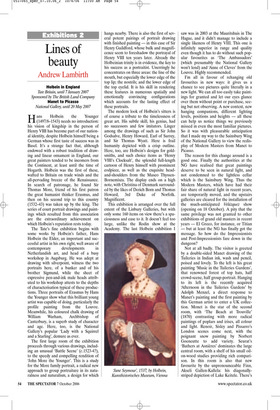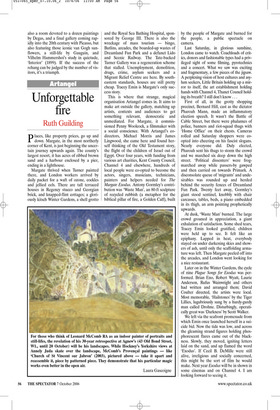Lines of beauty
Andrew Lambirth
Holbein in England Tate Britain, until 7 January 2007 Sponsored by The British Land Company Manet to Picasso National Gallery, until 20 May 2007 Hans Holbein the Younger (1497/8–1543) needs no introduction: his vision of kingship in the person of Henry VIII has become part of our national identity, despite Holbein himself being a German whose first taste of success was in Basel. It’s a strange fact that, although endowed with a robust tradition of drawing and linear ornament in England, our great painters tended to be incomers from the Continent, at least until the time of Hogarth. Holbein was the first of these, wafted to Britain on trade winds and the all-pervading breeze of the Renaissance. In search of patronage, he found Sir Thomas More, friend of his first patron the great humanist thinker Erasmus, and then on his second trip to this country (1532–43) was taken up by the king. The series of court portrait drawings and paintings which resulted from this association are the extraordinary achievement on which Holbein’s reputation rests today.
The Tate’s fine exhibition begins with some works by Holbein’s father, Hans Holbein the Elder, an important and successful artist in his own right, well aware of contemporary developments in Netherlandish art, and head of a busy workshop in Augsburg. He was adept at drawing with silverpoint, witness the two portraits here, of a banker and of his brother Sigmund, while the sheet of expressive pen-and-ink male heads attributed to his workshop attests to the depths of characterisation typical of these productions. Three portraits of Erasmus by Hans the Younger show what this brilliant young artist was capable of doing, particularly the profile painting from the Louvre. Meanwhile, his coloured chalk drawing of William Warham, Archbishop of Canterbury, is a superb study of character and age. Here, too, is the National Gallery’s popular ‘Lady with a Squirrel and a Starling’, demure as ever.
The first large room of the exhibition proceeds through various drawings, including an unusual ‘Battle Scene’ (c.1523-4?), to the speedy and compelling rendition of ‘John More the Younger’. This is a study for the More family portrait, a radical new approach to group portraiture in its naturalness and naturalism, a design for which hangs nearby. There is also the first of several potent pairings of portrait drawing with finished painting — in this case of Sir Henry Guildford, whose bulk and magnificence seem to foreshadow the portrayal of Henry VIII ten years later. Already the Holbeinian trinity is in evidence, the key to his success as a portraitist. Unerringly he concentrates on three areas: the line of the mouth, but especially the lower edge of the top lip; the nostrils; and the lower edge of the top eyelid. It is his skill in rendering these features in numerous spatially and emotionally convincing configurations which accounts for the lasting effect of these portraits.
The modern look of Holbein’s sitters is of course a tribute to the timelessness of great art. His subtle skill, his genius, had no successors and few imitators. Linger among the drawings of such as Sir John Godsalve, Henry Howard, Earl of Surrey, and Sir Thomas Wyatt. Here is frail humanity depicted with a crisp outline. Here, too, are Holbein’s designs for goldsmiths, and such choice items as ‘Henry VIII’s Clocksalt’, the splendid full-length cartoon of Henry himself with prominent codpiece, as well as the exquisite headand-shoulders from the Museo ThyssenBornemisza. The display ends on a high note, with Christina of Denmark surrounded by the likes of Derich Born and Thomas Howard, 3rd Duke of Norfolk. Magnificent.
This exhibition is arranged over the full extent of the Linbury Galleries, but with only some 160 items on view there’s a spaciousness and ease to it. It doesn’t feel too large, unlike the Rodin show at the Academy. The last Holbein exhibition I saw was in 2003 at the Mauritshuis in The Hague, and it didn’t manage to include a single likeness of Henry VIII. This one is infinitely superior in range and quality even though it has to do without such popular favourites as ‘The Ambassadors’ (which presumably the National Gallery won’t lend) and ‘Anne of Cleves’ from the Louvre. Highly recommended.
I’m all in favour of rehanging old favourites in new ways: it gives us a chance to see pictures quite literally in a new light. We can all too easily take paintings for granted and let our eyes glance over them without point or purchase, seeing but not observing. A new context, new hanging companions, different lighting levels, positions and heights — all these can help us notice things we previously missed in even the most familiar pictures. So it was with pleasurable anticipation that I made my way to the Sainsbury Wing of the National Gallery to view the redisplay of Modern Masters from Manet to Picasso.
The reason for this change around is a good one. Finally the authorities at the NG have realised that great paintings deserve to be seen in natural light, and not condemned to the lightless cellar which is the Sainsbury Wing. Thus the Modern Masters, which have had their fair share of natural light in recent years, are temporarily moved, and the upstairs galleries are cleared for the installation of the much-anticipated Velázquez show (opening on 18 October). A pity that the same privilege was not granted to other exhibitions of grand old masters in recent years — El Greco, for instance, or Titian — but at least the NG has finally got the message. So how do the Impressionists and Post-Impressionists fare down in the dungeon?
Not at all badly. The visitor is greeted by a double-sided Manet drawing of the Tuileries in Indian ink, wash and pencil, poised and lovely. To the left is his great painting ‘Music in the Tuileries Gardens’, that renowned forest of top hats, half crowd-scene, half group-portrait. Hanging to its left is the recently acquired ‘Afternoon in the Tuileries Gardens’ by Adolph Menzel, a direct response to Manet’s painting and the first painting by this German artist to enter a UK collection. Monet is the star of the second room, with ‘The Beach at Trouville’ (1870) contrasting with more radical paintings of poplars and irises, all colour and light. Renoir, Sisley and Pissarro’s London scenes come next, with the poignant snow painting by Norbert Goeneutte to add variety. Seurat’s ‘Bathers at Asnières’ dominates the large central room, with a shelf of his small oilon-wood studies providing rich comparison. In this room is also that new favourite by the unpronounceable Finn, Akseli Gallen-Kallela: his diagonallystriped depiction of Lake Keitele. There’s also a room devoted to a dozen paintings by Degas, and a final gallery coming rapidly into the 20th century with Picasso, but also featuring those iconic van Gogh sunflowers, a still-life by Gauguin, and Vilhelm Hammershoi’s study in quietude, ‘Interior’ (1899). If the success of the rehang can be judged by the number of visitors, it’s a triumph.



















































































 Previous page
Previous page